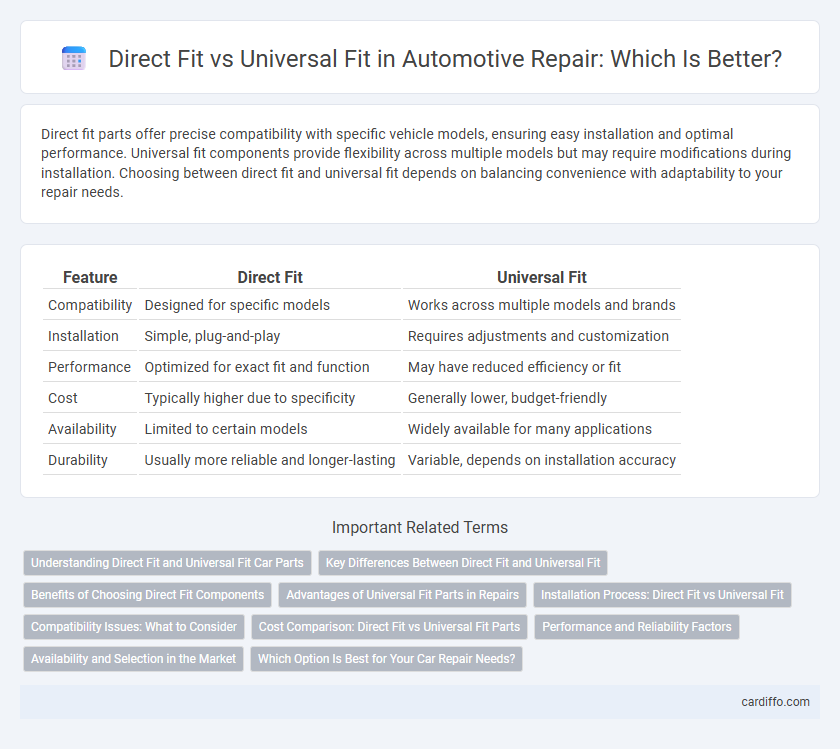Direct fit parts offer precise compatibility with specific vehicle models, ensuring easy installation and optimal performance. Universal fit components provide flexibility across multiple models but may require modifications during installation. Choosing between direct fit and universal fit depends on balancing convenience with adaptability to your repair needs.
Table of Comparison
| Feature | Direct Fit | Universal Fit |
|---|---|---|
| Compatibility | Designed for specific models | Works across multiple models and brands |
| Installation | Simple, plug-and-play | Requires adjustments and customization |
| Performance | Optimized for exact fit and function | May have reduced efficiency or fit |
| Cost | Typically higher due to specificity | Generally lower, budget-friendly |
| Availability | Limited to certain models | Widely available for many applications |
| Durability | Usually more reliable and longer-lasting | Variable, depends on installation accuracy |
Understanding Direct Fit and Universal Fit Car Parts
Direct fit car parts are designed to match the original equipment manufacturer (OEM) specifications precisely, ensuring easy installation without modifications. Universal fit parts offer broader compatibility across multiple models but may require adjustments or customization during repair. Choosing direct fit components guarantees a seamless repair process and optimal performance, while universal fit parts provide cost-effective flexibility for diverse vehicle needs.
Key Differences Between Direct Fit and Universal Fit
Direct fit parts are specifically designed to match the original equipment manufacturer (OEM) specifications, ensuring precise compatibility and easy installation for seamless repair. Universal fit parts offer broader compatibility across multiple models and brands but may require modifications or adjustments during installation, potentially affecting the repair quality or performance. Choosing between direct fit and universal fit involves balancing exact fit and ease of installation against versatility and cost-effectiveness in repair projects.
Benefits of Choosing Direct Fit Components
Direct fit components ensure precise compatibility with the original equipment, reducing installation time and minimizing the risk of malfunctions. These parts maintain the vehicle's factory specifications, enhancing overall performance and safety. Choosing direct fit options often leads to longer durability and fewer adjustments compared to universal fit alternatives.
Advantages of Universal Fit Parts in Repairs
Universal fit parts offer significant advantages in repairs by providing compatibility across a wide range of vehicle makes and models, reducing the need for extensive inventory. Their flexibility streamlines the repair process, minimizing downtime and simplifying sourcing for technicians. Cost-effectiveness and availability make universal fit parts an ideal choice for quick and efficient vehicle maintenance and repair.
Installation Process: Direct Fit vs Universal Fit
Direct fit parts offer a straightforward installation process designed to match the original specifications of the vehicle, reducing the need for modifications and ensuring a precise fit. Universal fit components require additional adjustments, such as trimming or adapting mounting points, which can extend installation time and demand more technical skills. Choosing direct fit parts minimizes labor costs and installation errors compared to the flexible but more complex universal fit options.
Compatibility Issues: What to Consider
Direct fit parts offer precise compatibility by matching OEM specifications, ensuring seamless integration without modifications. Universal fit components provide broader versatility but may require adjustments, risking improper alignment or functionality. Consider vehicle model, part dimensions, and connector types to avoid compatibility issues during repairs.
Cost Comparison: Direct Fit vs Universal Fit Parts
Direct fit parts typically cost more upfront due to their precise specifications and OEM standards, ensuring seamless compatibility and reduced risk of installation errors. Universal fit parts are generally more affordable, offering a budget-friendly alternative but may require additional modifications, increasing labor costs and potential adjustment time. Evaluating total expenses involves balancing part price with installation complexity and long-term reliability.
Performance and Reliability Factors
Direct fit parts ensure optimal performance by matching exact manufacturer specifications, resulting in seamless integration and consistent reliability over time. Universal fit components offer versatility and broader compatibility but may compromise performance due to minor differences in design and tolerances. Prioritizing direct fit parts is essential for high-reliability applications where precision and longevity are critical.
Availability and Selection in the Market
Direct fit parts offer high availability for specific vehicle makes and models, ensuring precise compatibility and simplified installation. Universal fit parts provide a broader selection across various brands but often require modifications during repair, limiting ease of use. Market availability of direct fit components is more concentrated around popular vehicles, while universal parts dominate in aftermarket catalogs due to their versatility.
Which Option Is Best for Your Car Repair Needs?
Direct fit parts guarantee compatibility by matching the original manufacturer's specifications, ensuring seamless installation and optimal performance in your car repair. Universal fit parts offer flexibility and cost savings but may require modifications, potentially affecting fit and function. Choosing between the two depends on your budget, repair complexity, and the importance of precision versus adaptability in your vehicle maintenance.
Direct fit vs universal fit Infographic

 cardiffo.com
cardiffo.com